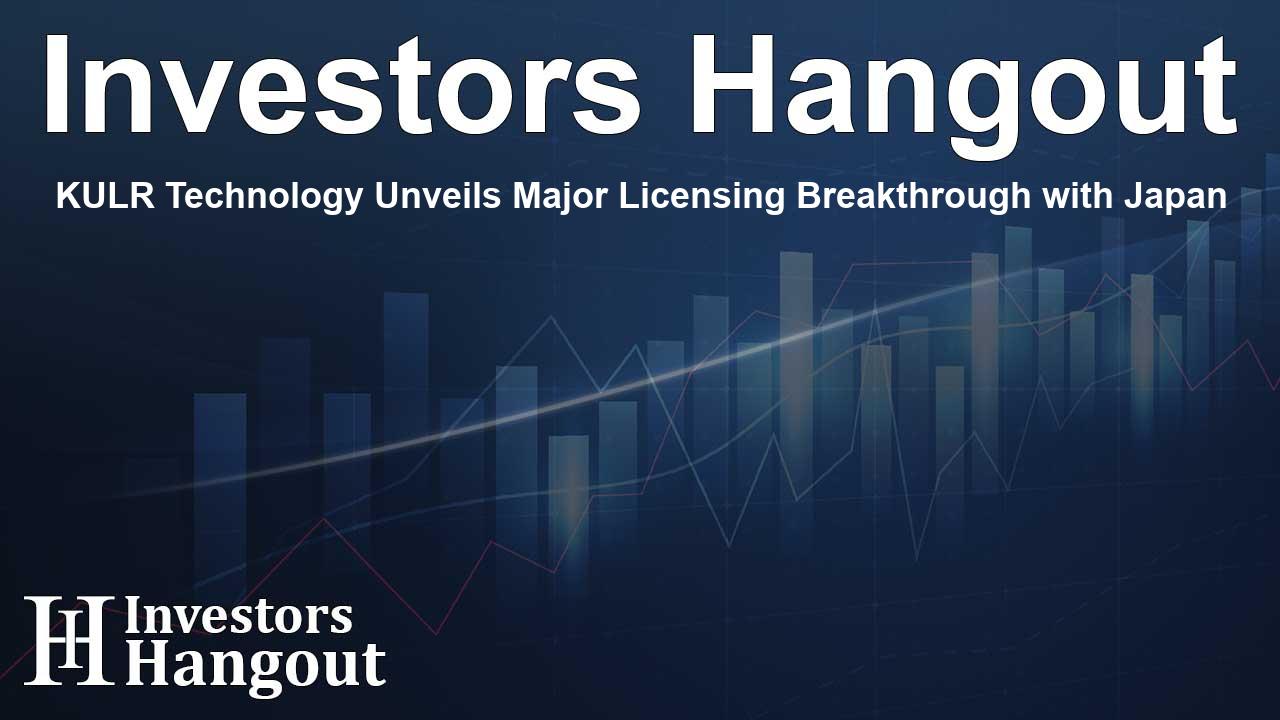KULR Technology Unveils Major Licensing Breakthrough with Japan

KULR Technology Unveils Major Licensing Breakthrough
KULR Technology Group, Inc. (NYSE American: KULR), a pioneer in sustainable energy management, recently announced an impressive licensing agreement for its cutting-edge vibration reduction technology, KULR Xero Vibe (KXV). This deal, valued at $2.35 million, marks a significant milestone in the company’s growth, providing an opportunity to expand its market reach and explore exciting new business avenues.
Details of the Licensing Agreement
The licensing agreement entails a minimum guaranteed license and royalty fee of $1.1 million and offers the licensee—an advanced semiconductor solutions firm based in Japan—the opportunity to purchase proprietary balancing equipment directly from KULR. This strategic partnership aims to utilize KXV technology to balance industrial-scale fan systems in diverse applications, such as data center cooling and HVAC systems. As demand surges for efficient cooling solutions, there is enormous revenue potential as KULR continues to delve into new geographic markets and related power-consuming applications.
The Revolutionary KXV Technology
KULR’s KXV technology is designed to balance high-performance commercial fans that operate at remarkable speeds of over 33,000 RPM. With the escalating energy requirements of AI-driven data centers, where cooling systems become vital, the KXV system’s ability to drastically reduce vibration enhances overall cooling efficiency and contributes to energy savings.
Innovation Meets Environmental Sustainability
KULR’s CEO, Michael Mo, highlighted intriguing energy consumption statistics, stating that a ChatGPT query can use nearly ten times the electricity of a Google search. According to insights from industry analysts, the power consumption of data centers is expected to rise substantially as AI technologies proliferate. KXV not only mitigates vibration but also plays a critical role in boosting energy efficiency, thus paving the way for more sustainable operations in tough market conditions.
Additional Benefits of KXV Technology
KULR's KXV technology does not just enhance cooling energy efficiency; it offers a myriad of additional advantages for data centers:
- Noise Reduction for Enhanced Comfort: Lower vibration translates to quieter operations, contributing to a more conducive work environment.
- Improved Stability for Optimal Performance: Systems equipped with KXV exhibit enhanced reliability and operational smoothness.
- Reduced Wear and Tear: The dramatic reduction in vibration lowers mechanical stress on cooling systems, prolonging their lifespan and cutting down maintenance costs.
Impact on the Data Center Industry
Energy consumption stands as a leading operational expense for data centers, with cooling costs notably accounting for a significant portion—nearly 40%. By adopting KULR’s KXV technology, companies can not only minimize operational costs but also transition towards more sustainable practices. Vigilant steps towards energy efficiency are underscored by trends among major corporations, showcasing the pressing need for reliable cooling technologies in the current climate.
The Energy Efficiency Trend
Leading companies in the tech industry, like Microsoft and Oracle, are already making strides towards greener technology. Their endeavors reflect the growing emphasis on energy efficiency, and KULR’s innovative approaches align perfectly with these industry shifts. As companies look for solutions to combat rising energy costs while improving operational efficiency, KULR’s technology is poised to play an instrumental role.
About KULR Technology Group
KULR Technology Group, Inc. (NYSE American: KULR) is at the forefront of energy storage solutions tailored for space, aerospace, and defense sectors. The company's comprehensive expertise in battery design, testing, and production enables it to deliver next-generation energy storage systems rapidly and cost-effectively. More details about their revolutionary products can be found on their official website.
Frequently Asked Questions
What is the KULR Xero Vibe technology?
The KULR Xero Vibe (KXV) technology focuses on vibration reduction for high-speed commercial fans, enhancing cooling efficiency for data centers.
How much is the licensing deal with the Japanese corporation?
The licensing agreement is valued at $2.35 million, with a guaranteed minimum fee of $1.1 million.
What industries can benefit from KXV technology?
KXV technology is ideal for data centers and HVAC systems, providing efficiency in industrial-scale fan applications.
How does KXV technology improve energy efficiency?
By virtually eliminating vibration, KXV enhances the performance of cooling systems, reducing energy consumption and operational costs.
Where can I learn more about KULR Technology Group?
For more information, you can visit KULR Technology Group's official website.
About Investors Hangout
Investors Hangout is a leading online stock forum for financial discussion and learning, offering a wide range of free tools and resources. It draws in traders of all levels, who exchange market knowledge, investigate trading tactics, and keep an eye on industry developments in real time. Featuring financial articles, stock message boards, quotes, charts, company profiles, and live news updates. Through cooperative learning and a wealth of informational resources, it helps users from novices creating their first portfolios to experts honing their techniques. Join Investors Hangout today: https://investorshangout.com/
Disclaimer: The content of this article is solely for general informational purposes only; it does not represent legal, financial, or investment advice. Investors Hangout does not offer financial advice; the author is not a licensed financial advisor. Consult a qualified advisor before making any financial or investment decisions based on this article. The author's interpretation of publicly available data shapes the opinions presented here; as a result, they should not be taken as advice to purchase, sell, or hold any securities mentioned or any other investments. The author does not guarantee the accuracy, completeness, or timeliness of any material, providing it "as is." Information and market conditions may change; past performance is not indicative of future outcomes. If any of the material offered here is inaccurate, please contact us for corrections.